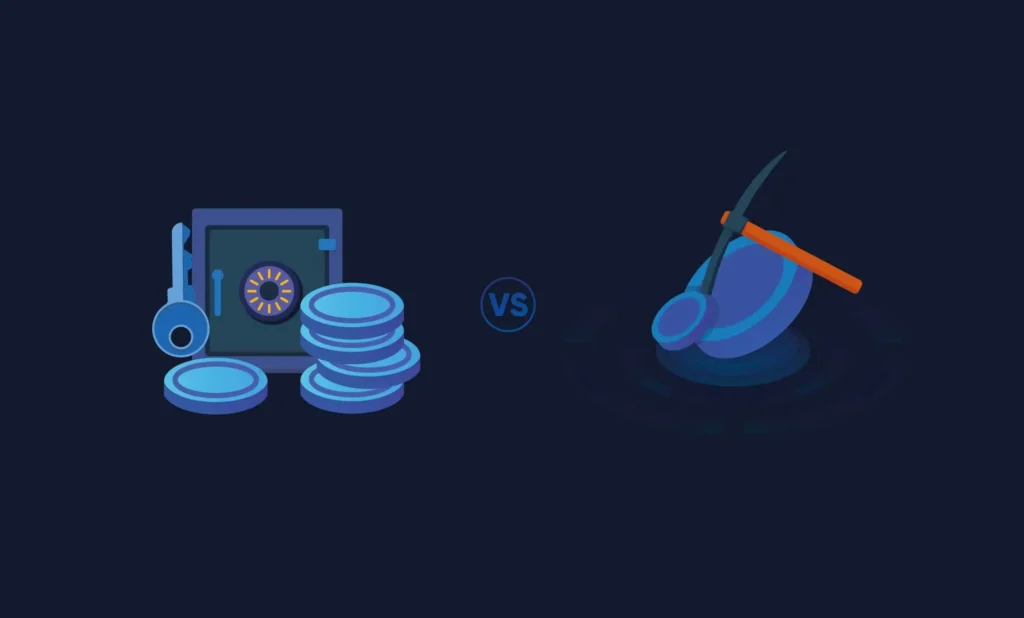Proof of Work (PoW) and Proof of Stake (PoS) are two consensus mechanisms used by blockchain networks to verify transactions and maintain network security. They have different approaches to solving the same problem: ensuring that transactions are validated fairly and securely without the need for a central authority. Let’s break them down:

Content
Proof of Work (PoW)
How it works:
- PoW is the original consensus mechanism used by blockchains like Bitcoin and Ethereum (until Ethereum switched to PoS in 2022).
- In PoW, miners compete to solve complex mathematical puzzles using computational power. These puzzles are hard to solve but easy to verify once a solution is found.
- The first miner to solve the puzzle gets the right to add a new block of transactions to the blockchain.
- As a reward, the miner receives newly minted cryptocurrency (for example, Bitcoin) and transaction fees from the block they verified.
Key Characteristics:
- Security: PoW is highly secure because solving the puzzles requires significant computational power. This makes it very difficult for bad actors to take over the network (they would need over 51% of the total computational power to do so, which is prohibitively expensive).
- Energy Consumption: PoW requires enormous amounts of energy because miners are constantly using powerful computers to solve these puzzles. Bitcoin mining, for instance, consumes more electricity annually than some countries, which has raised environmental concerns.
- Decentralization: PoW networks are generally decentralized because anyone with enough computational power can become a miner. However, over time, mining has become dominated by large mining farms with specialized hardware, leading to some concerns about centralization.
Pros of PoW:
- Proven security model, used by Bitcoin since its inception.
- Resistant to certain types of attacks, such as double-spending.
Cons of PoW:
- High energy consumption.
- Mining is expensive, which can lead to centralization among those who can afford the necessary hardware.
- Slow transaction speeds compared to newer mechanisms.
Proof of Stake (PoS)
How it works:
- PoS was developed as an alternative to PoW to address some of its limitations, particularly energy consumption. Ethereum, for instance, transitioned from PoW to PoS in 2022 with its “Ethereum 2.0” upgrade.
- In PoS, validators (instead of miners) are chosen to create new blocks and validate transactions. Instead of competing to solve puzzles, validators are selected based on the amount of cryptocurrency they hold and are willing to “stake” (lock up as collateral).
- The more tokens a person holds, the more likely they are to be chosen as a validator.
- Validators are rewarded with transaction fees and, in some cases, newly minted cryptocurrency. However, if they try to act dishonestly, they can lose some or all of their staked tokens.
Key Characteristics:
- Energy Efficiency: PoS uses significantly less energy than PoW because it doesn’t rely on solving computational puzzles. The selection of validators is based on stake, not power-hungry mining hardware.
- Decentralization and Security: PoS networks tend to be more accessible than PoW because participants don’t need expensive mining equipment—just the native cryptocurrency of the network. However, large stakeholders can have outsized influence, which raises concerns about potential centralization.
- Incentive Structure: Validators are financially incentivized to act honestly. If they validate bad transactions or act maliciously, they can lose part of their stake (a process known as slashing). This keeps the system secure while using fewer resources than PoW.
Pros of PoS:
- Much lower energy consumption compared to PoW.
- Faster and more scalable, as blocks can be created more quickly.
- Encourages participants to hold onto the native cryptocurrency (since staking is necessary to validate transactions), which can help stabilize the currency’s price.
Cons of PoS:
- Validators with larger stakes have more influence, which can potentially lead to centralization.
- Less battle-tested than PoW (although PoS is growing in popularity and proving itself on networks like Ethereum).
- Potential for the “rich get richer” problem, as validators with more tokens have a higher chance of being chosen and earning more rewards.
Key Differences Between PoW and PoS
- Energy Use:
- PoW is energy-intensive because of the computational power required for mining.
- PoS is energy-efficient since it doesn’t require mining, just staking.
- Security Model:
- PoW relies on computational power to secure the network.
- PoS relies on financial incentives—validators risk losing their staked tokens if they behave dishonestly.
- Decentralization:
- PoW can become centralized around those with access to massive computing resources (mining farms).
- PoS risks centralization if a small number of individuals or organizations control a large amount of the cryptocurrency.
- Speed and Scalability:
- PoW networks tend to be slower and harder to scale due to the time and energy required to solve puzzles.
- PoS networks are generally faster and more scalable because they don’t involve complex mining operations.
Which Is Better?
There’s no one-size-fits-all answer to this. PoW is tried and tested, providing a high level of security and decentralization, particularly in Bitcoin’s case. However, its energy consumption and slower transaction times are drawbacks. PoS, on the other hand, offers a more energy-efficient and scalable solution, which is why it’s being adopted by networks like Ethereum.
For a greener future and a more scalable blockchain, PoS appears to be the consensus mechanism that will dominate, but PoW remains essential for networks like Bitcoin that prioritize security and decentralization over scalability.

As a writer, Richard is an advocate of blockchain technology and cryptocurrency in general. He writes about all things from cryptography to economics, with a focus on how it applies to cryptocurrencies. He is also passionate about writing about topics such as decentralization, open-sourced software development, and copyright law.


